Exploring the world is a growing process for every child. Of course, there may be many dangers in the process of exploration. Since they do not have enough cognitive ability to many things, they are likely to touch hot objects or put their fingers (or mouth) ) where it doesn't belong to scald her wandering hands. Burns in children are also one of the most common accidents . Of course, there are many ways to prevent burns in children, but if they do occur, you should know how to treat them. This article will introduce you to the little knowledge about accidental burns in children . When accidental burns occur, you can properly save your child.
The severity of burns in children varies - and they are categorized by severity:
①First - degree burns ( mild ): Only the superficial layer of the skin is affected . Your child's skin will be red and swollen without blisters, but she will feel some pain.
②Second -degree burns ( moderate ): involving the first and second layers of skin. Your child's skin will be bright red, swollen, blistered, and painful.
③ Third-degree burns ( severe ): involving all skin layers and subcutaneous tissue. Your child's wound looks burnt, black, white, leathery, or waxy. She probably won't feel any pain from the damaged nerves in the skin.
So how should children be treated for burns and scalds ?
Here's what to do in an emergency after a burn :
①Away from the fire and heat sources, please take your child to a safe place. If there is a fire on the child, please wrap him with a blanket.
②Please rinse the burned area with cold water for at least five minutes. The advantage of this is that the blood vessels on the wound surface can be constricted, the exudation of tissue fluid can be reduced, and the formation of blisters can be reduced. Then you can take off the child's clothes, because the clothes will be sticky Cover the skin, usually with scissors to cut the collar, sleeves or socks worn on the feet, being careful not to break the blisters of the wound.
③If there is a blister, please don't pick it right away, it is easy to cause infection.
④ If the injury is serious and the area is relatively large, please call an ambulance and take it to the hospital in time.
What are the characteristics of burns in children?
① One of the characteristics of burns in children is that the younger the age, the thinner the skin, so the burns tend to be deeper than in adults.
②Low temperature burns caused by hot carpets or portable body warmers may appear mild, but they penetrate deep into the skin, so care must be taken.
③According to the growth and development of the child, by making efforts to prevent accidents, burns can be prevented.
How to treat mild (first and minor second degree) burns in children ?
If you have a baby at home, please keep some disinfectant tools and functional dressings for wound treatment. These can be used in case of emergencies. Here are some functional dressings for burns and scalds:
① Longterm Medical Hydrocolloid Dressing: It is a medical polymer dressing, which can provide a slightly acid-sealed moist healing environment for wounds, and can prevent the invasion of foreign microorganisms and reduce the chance of wound infection. It is suitable for superficial wounds, has good adhesiveness, and is not painful to tear off.
② Longterm Medical Hydrogel Dressing: It is a functional dressing with higher water content than hydrocolloids. It is more comfortable to use, suitable for severe burns and scalds, and can relieve wound pain. Due to its high water content and good flexibility With biocompatibility, the wound can effectively avoid secondary damage caused by wound adhesion.
③ Longterm Medical Silicone Scar dressing: It is a functional dressing used after the wound has healed. This dressing can reduce the formation of scars and lighten the effect of scars. It can be used after the wound has healed to prevent the proliferation of scars. The dressing has no pure physical effect and does not add any drugs. It is very safe. Please rest assured to use it for your baby.
After rinsing immediately after a burn, pat the skin dry. Then use Hydrocolloid Dressing or Hydrogel Dressing to apply it to the scalded area. If the blisters are not more than 5 mm in diameter, they do not need to be punctured, just wait for the skin to absorb themselves. Silicone Scar dressing can be applied after the wound has healed to reduce scarring.
If your child has severe burns, please go to the hospital for treatment as soon as possible. Your pediatrician will recommend aloe vera or other topical ointment (you'll need a prescription) to treat burns, but minor burns usually heal with a functional dressing . Just watch for signs of infection - redness, fever, swelling or oozing. Depending on the burn, your doctor may recommend that you avoid exposing the area to sunlight for several months to prevent your child's skin from discoloring.
For more information on Innomed® dressings, refer to the previous articles. If you have customized needs, you are welcome to contact us; we will serve you wholeheartedly.
At Longterm Medical, we transform this data by innovating and developing products that make life easier for those who need loving care.
Editor: kiki Jia
Date: August 24 , 2022

 English
English عربى
عربى Español
Español русский
русский 中文简体
中文简体








